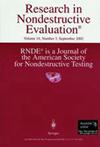Characteristics of Eddy Current Attenuation in Double-Layer Metallic Plate and Measurement of Gap Thickness
IF 1.6
4区 材料科学
Q3 MATERIALS SCIENCE, CHARACTERIZATION & TESTING
引用次数: 0
Abstract
ABSTRACT Multilayer metallic plate is made by stacking homogeneous or heterogeneous metallic plates and connecting them with fasteners. The air-gap thickness between the adjacent layers affects the performance of the plate structure. The eddy current testing (ECT) technology has been used for the nondestructive testing of multilayer plate. However, the effect of air gap on the characteristics of eddy current (EC) attenuation in multilayer plate remains unclear and the study of the relation between the response of the EC probe and the gap thickness is very limited. The computation results of the paper show that the air gap in a double-layer plate reduces the amplitude of EC density in the bottom layer and decreases the rate of EC attenuation in the top layer. The mechanism is revealed. The effect of gap thickness on probe response is investigated. It is found that the presence of air gap makes the EC response either larger or smaller, depending on the working frequency. The reason is explained based on the characteristics of EC attenuation. Thereupon, the experiment of measuring gap thickness using the ECT is carried out.双层金属板涡流衰减特性及间隙厚度测量
多层金属板是将均质或非均质金属板堆叠在一起,用紧固件连接而成。相邻层间的气隙厚度影响板结构的性能。涡流检测(ECT)技术已被用于多层板的无损检测。然而,气隙对多层板涡流衰减特性的影响尚不清楚,对气隙厚度与电涡流探头响应关系的研究非常有限。计算结果表明,双层板的气隙降低了底层电火花密度的幅值,降低了顶层电火花衰减的速率。机理被揭示。研究了间隙厚度对探头响应的影响。研究发现,气隙的存在使EC响应随工作频率的不同而增大或减小。从电火花衰减特性出发,解释了其原因。在此基础上,进行了电痉挛测量间隙厚度的实验。
本文章由计算机程序翻译,如有差异,请以英文原文为准。
求助全文
约1分钟内获得全文
求助全文
来源期刊

Research in Nondestructive Evaluation
工程技术-材料科学:表征与测试
CiteScore
2.30
自引率
0.00%
发文量
14
审稿时长
>12 weeks
期刊介绍:
Research in Nondestructive Evaluation® is the archival research journal of the American Society for Nondestructive Testing, Inc. RNDE® contains the results of original research in all areas of nondestructive evaluation (NDE). The journal covers experimental and theoretical investigations dealing with the scientific and engineering bases of NDE, its measurement and methodology, and a wide range of applications to materials and structures that relate to the entire life cycle, from manufacture to use and retirement.
Illustrative topics include advances in the underlying science of acoustic, thermal, electrical, magnetic, optical and ionizing radiation techniques and their applications to NDE problems. These problems include the nondestructive characterization of a wide variety of material properties and their degradation in service, nonintrusive sensors for monitoring manufacturing and materials processes, new techniques and combinations of techniques for detecting and characterizing hidden discontinuities and distributed damage in materials, standardization concepts and quantitative approaches for advanced NDE techniques, and long-term continuous monitoring of structures and assemblies. Of particular interest is research which elucidates how to evaluate the effects of imperfect material condition, as quantified by nondestructive measurement, on the functional performance.
 求助内容:
求助内容: 应助结果提醒方式:
应助结果提醒方式:


